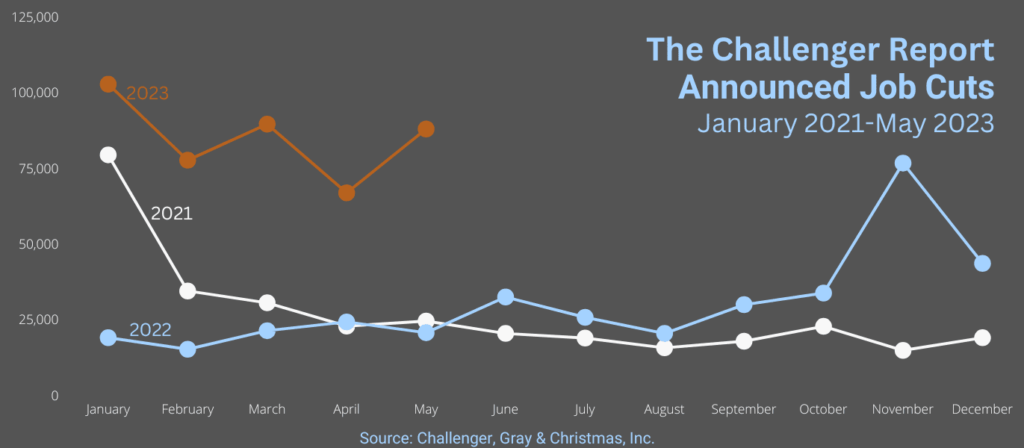Traumatic 12 months of technology layoffs

|
Getting your Trinity Audio player ready...
|
Tech layoffs in 2023 are on track to be worse than the previous year. From the start of the year through the end of May, companies announced plans to cut 417,500 jobs, up 315% from the same period last year.
This year, January saw the most layoffs with 84,714 employees losing their jobs. Things have slowed somewhat, as May saw the fewest layoffs, clocking in at 14,555.
Perhaps what’s so alarming about the tech layoffs is that they’re happening at big-name tech companies as well. LinkedIn, which saw its revenue grow at every quarter last year, announced plans to lay off 716 staff on May 8th.
In a letter to employees, LinkedIn CEO Ryan Roslansky said the move to cut roles in its sales, operations and support teams was aimed at streamlining the company’s operations and would remove layers to help make quicker decisions.
Roslansky also said in the letter that the changes will eventually create 250 new jobs. A spokesperson said that employees affected by the cuts would be eligible to apply for those roles (lucky them!).
The China-focused job application InCareer, run by LinkedIn, will be shut down. The reasoning behind this and the job cuts is that the weakening global economic outlook makes it necessary to take precautions (its parent company Microsoft has also made huge cuts).
Technology layoffs in 2023
So far in 2023:
- Amazon layoffs lead the 2023 numbers with 16,000 roles cut as of mid-May.
- Layoffs at Alphabet, the parent company of Google, total about 12,000.
- Microsoft’s layoffs total about 10,000 workers, as do Facebook parent Meta’s layoffs.
- Ericsson follows up with 8,500 layoffs.
Together with Salesforce, these tech companies conducted the largest layoffs of the past two years, totalling tens of thousands of roles. A more comprehensive list of tech layoffs in 2023 is available here.

Charting tech layoffs from 2021 to 2023
While the numbers are alarming, as of early April 2023 the combined layoffs at these companies represent only 8% of the number of new hires they made during the pandemic.
YOU MIGHT LIKE

The dimming of the DE&I light in recent tech layoffs
During the pandemic, the tech industry – particularly the ecommerce sector – saw a boom period as global lockdowns caused an uptick in hardware sales. To keep up with demand, big tech went on a hiring binge – now a purge must complete the cycle.
The rapid growth between 2019 and 2022 has ended and fears of a recession are mounting, particularly as supply chain issues, inflation, and the war in Ukraine impact business and consumer spending.
“Consumer confidence is down to a six-month low and job openings are flattening. Companies appear to be putting the brakes on hiring in anticipation of a slowdown,” said Andrew Challenger, labor expert and Senior Vice President of Challenger, Gray & Christmas, Inc.
Retailers laid off 45,168 workers through May, while financial firms announced 36,937 cuts, the firm found. The media industry slashed 17,436, its highest year-to-date tally on record.
Don’t panic just yet: although tech companies are letting staff go, tech experts might be safe. Alongside the headlines declaring mass-firings you might have noticed talk of a tech skills shortage. Despite hundreds of thousands of employees in the technology sector being laid off, the need for experts hasn’t been filled.
Who’s worst affected by tech layoffs in 2023?
The majority of people being laid off by technology companies don’t work in the tech department; less than a quarter of job losses are techies. Should the worst happen, and an industry expert does get the sack, they’ll not struggle to find a new role.
Demand for tech skills is high and many technology professionals who lose one job are able to start the next one almost immediately. Plus, virtually all – about 90% – techies laid off stay in the technology sector. 40% of them move to smaller companies and start-ups.
Despite layoffs, workers and those seeking work continue to have the upper hand in today’s U.S. economy, which still has far fewer people looking for work (5.5 million) than the number of job openings (10.1 million).
Findings revealed in “Europe’s New Tech Founders 2023” report show that despite the tech downturn, Europe’s founder ecosystem continues to thrive with unprecedented surge of new entrepreneurs entering the market.

Source: Antler via https://drive.google.com/file/d/1e7JH26nUGv8_4KDvEI5JbwOerJDzWw7a/view?pli=1
There’s an influx of founder talent driven by tech layoffs: in the 12 months after a company announces layoffs, a 391% increase was identified in applications from employees looking to become aspiring tech founders.
What are the signs of tech layoffs ahead?
If you want to get ahead on planning for a last resort start-up, there are some signs that indicate that staffing cuts are coming.
Most obviously, paying attention to your company’s financial health will indicate whether personnel costs are becoming too much. Take notice of earnings reports and guidance, as well as share price movements.
Often, a business’s investors are privy to information that staff may be unaware of. As such, take on the role of investor when you do your research. Monitor investors’ news about your company just in case you catch something that didn’t make the weekly email.
Another indicator would be a freeze in hiring, payroll or promotions. Payroll is the most significant cost to most companies, and to alleviate the pressures of the worsening economic climate ensuring that it doesn’t become a bigger expense is crucial.
Alongside a pause in hiring, restructuring and streamlining operations is another way to cut costs. Doing so often comes with increased outsourcing and all of it – as happened at LinkedIn last month – leads to layoffs.
Vivian Tu, a former trader turned influencer who goes by “Your Rich BFF” shared an Instagram video in which she advises keeping track of WARN notices. WARN notices get their name from the Worker Adjustment and Retraining Notification Act of 1988, a labor-projection law that requires companies with 100 or more employees to provide a 60 calendar-day notice of planned closing and layoffs.
Tu says check WARN notices in your state (WARN is US-only) and others where your company does business to see lists of companies letting go of employees.
This method isn’t fool proof, however. Sometimes companies avoid having to release these notices by staggering when layoffs will happen, says Susan Houseman, director of research for the W.E. Upjohn Institute for Employment Research.
“So maybe you’re going to lay off 75, say you lay off 40 one month and 26 the next to avoid WARN notice,” she said.
The law also allows for exceptions when a company was unable to provide two months’ notice if the layoffs are the result of an unforeseen circumstance. “All of a sudden something happens, demand for your product does a sudden nose[dive], and you just have to lay off workers, and you don’t have time to give them a 60-day notice,” Houseman said.
Tech layoffs don’t appear to be stopping, but they have slowed. Keeping on top of the latest news will enable you, at the very least, to be prepared should the worst happen. You can track layoffs here.








